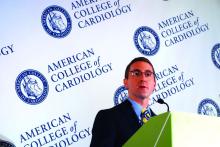WASHINGTON – Surgical left atrial appendage occlusion in older patients with atrial fibrillation already undergoing cardiac surgery was associated with a 38% reduction in thromboembolism and a 15% lower risk of all-cause mortality during the subsequent year in a large observational study.
“Although randomized trial data are needed, our study demonstrates strong support for the benefits of closing the left atrial appendage at the time of cardiac surgery in patients with atrial fibrillation,” Daniel J. Friedman, MD, said at the annual meeting of the American College of Cardiology.
His retrospective comparative effectiveness study included 10,524 Medicare patients in the Society of Thoracic Surgeons database for 2011-2012. This comprehensive database includes more than 1,000 participating centers and roughly 90% of all cardiothoracic surgery programs in the United States. All study patients had atrial fibrillation and were undergoing first-time on-pump cardiac surgery, either coronary artery bypass graft alone or together with mitral or aortic valve surgery at the same time. This was a group at high thromboembolic risk as reflected in their median CHA2DS2-VASc score of 4.Thirty-seven percent of patients underwent surgical left atrial appendage occlusion (LAAO) at the time of their primary heart operation. They were slightly younger, more often female, in better cardiovascular health, and more likely to have their surgery at an academic medical center than were patients who didn’t have LAAO. Adjustment for all of these factors was made in the statistical analysis.
The primary outcome was rehospitalization for thromboembolism – that is, ischemic stroke, transient ischemic attack, or other systemic arterial embolism – within 1 year. This occurred in 1.6% of the LAAO group and 2.5% of the non-LAAO group, for an unadjusted 37% and an adjusted 38% relative risk reduction, reported Dr. Friedman, a cardiology research fellow at the Duke Clinical Research Institute in Durham, N.C.
Turning to prespecified secondary endpoints, he noted that the all-cause mortality rate at 1 year was 7.0% in the LAAO group and 10.8% in the comparison arm, for a significant adjusted 15% risk reduction in the closure group. The composite endpoint of thromboembolism, hemorrhagic stroke, or death occurred in 8.7% of the LAAO group compared with 13.5% of non-LAAO patients, representing an adjusted 30% reduction in risk.
In an exploratory analysis, Dr. Friedman and his coinvestigators determined that, in patients discharged without oral anticoagulation, LAAO was associated with a 71% reduction in risk of thromboembolism. In contrast, LAAO didn’t significantly affect thromboembolic risk in patients discharged on an oral anticoagulant.
The STS database did not include information on the methods or completeness of LAAO.
Discussant David J. Wilber, MD, urged care in attempting to translate the study findings into clinical practice.
“I must say, given the diversity of surgical occlusion techniques – everything from excision to internal sutures to external clipping and stapling – I’m really a bit surprised to see the relatively strong outcomes, with a very strong signal for reduction in thromboembolism and also an opportunity to decrease mortality. I guess I’d say I’d be a little bit cautious. I’d want to see data assessing the completeness of closure and its success long term before we take this to heart clinically,” said Dr. Wilber, professor of cardiology and pediatrics and codirector of the Cardiovascular Research Institute at Loyola University in Maywood, Ill.
Dr. Friedman shared Dr. Wilber’s reservations about applying these observational data to clinical practice.
“I think what we can say is that this study supports the concept that the left atrial appendage is important as a source of thromboembolism in atrial fibrillation, and that exclusion of the left atrial appendage can be a potentially viable treatment option for patients,” he said. “I think it’s going to be increasingly important to bring this up as a possible treatment option when we’re discussing cardiac surgery with our heart teams – and that means talking to the surgeon, the cardiologist who may be following the patient afterwards, and even the cardiothoracic anesthesiologist who’s going to be manning the transesophageal echo probe and may be able to give us some insight as to the quality of closure before the patient leaves the operating room.”
There is considerable surgical interest in LAAO for stroke prevention in AF in light of the success of the percutaneous Watchman device. However, many cardiothoracic surgeons have refrained from performing the brief occlusion procedure because of what up until now has been a lack of evidence as to safety and efficacy.
Asked if his study findings imply that oral anticoagulation can routinely be stopped after LAAO provided the surgeon believes the appendage has been successfully excluded from the circulation, Dr. Friedman replied that he does not.
Although the left atrial appendage has been implicated as the site of thrombus formation in 90% of thromboembolic events occurring in patients with AF, ligation of the appendage doesn’t address that other 10%. Dr. Friedman said he believes it’s appropriate to await the results of an ongoing prospective randomized trial of LAAO led by investigators at McMaster University in Hamilton, Ont.
Dr. Friedman reported having no financial conflicts regarding his study, funded by the Burroughs Welcome Fund and the Food and Drug Administration.


